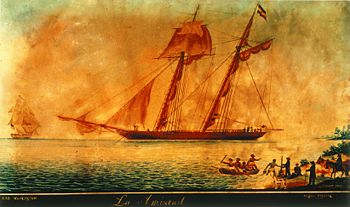|
|||
|
Philatelia.Net / Pirates. Bandits. Adventurers / Plots / The directory «Plots»«La Amistad»La Amistad (Spanish: "Friendship") was a 19th-century two-masted schooner of about 120 feet. Built in the United States, La Amistad was originally named Friendship but was renamed after being purchased by a Spaniard. La Amistad became a symbol in the movement to abolish slavery after a group of African captives aboard revolted in July 1839. Its recapture resulted in a legal battle over their status. On July 2, 1839, Africans being carried aboard La Amistad from Havana were led by fellow captive Sengbe Pieh, known in America as Joseph Cinqué, in a revolt against their captors. After gaining control of the ship, the Africans demanded to be returned home, but the ship’s navigator deceived them about their course, and sailed them north along the North American coast to Long Island, New York. The schooner was subsequently taken into custody by the United States Navy and the Africans were taken to Connecticut to be sold as slaves. There ensued a widely publicized court case in New Haven, CT about the ship and the legal status of the African captives. At that time the transport of slaves from Africa to the Americas was illegal, so they were fraudulently described as having been born in Cuba. It needed to be decided whether the Africans could be considered salvage and the property of Naval officers who had taken custody of the ship, whether they were the property of the Cuban buyers, or of Spain as the Queen of Spain claimed, or lastly if the circumstances of their capture and transportation meant they were free. The issues became the focus of the Amistad (1841) Supreme Court case, which figured prominently in abolitionism in the United States. After being moored at the wharf behind the Custom House in New London, Connecticut, for a year and a half, La Amistad was auctioned off by the U.S. Marshal in October 1840. Captain George Hawford, of Newport, Rhode Island, purchased the vessel and then had to get an Act of Congress passed so that he could register her. He renamed her Ion and, in late 1841, sailed her to Bermuda and Saint Thomas with a typical New England cargo of onions, apples, live poultry, and cheese. After sailing her for a few years, he sold the boat in Guadeloupe in 1844. There appears to be no record of what became of the Ion under her new French owners in the Caribbean. Ghana, 1998, «La Amistad» Netherlands Antilles, 2010, «La Amistad» Sierra Leone, 1984/1985, Schooner «La Amistad» Advertising: |
|||
© 2003-2025 Dmitry Karasyuk. Idea, preparation, drawing up
|

